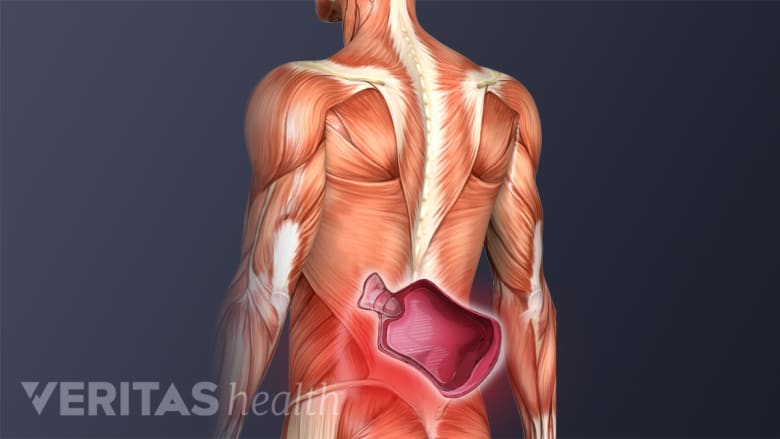The treatment of back pain in pregnancy depends on the stage of pregnancy, underlying cause, aggravating factors, and the presence of other medical conditions, such as diabetes or heart problems. Both medical and psychological treatments may be warranted in some cases when the ability to perform daily activities and participation in social events is significantly affected, impairing the quality of life.
The management approach is typically multidisciplinary and may include treatments from an obstetrician, orthopedic specialist, neurologist, and/or neurosurgeon. Physicians evaluate the posture, range of motion in the lower extremities, leg-length inequality, tendon reflexes, gait pattern, joint pain, and the degree of curvature in the lower spine. Maintaining an optimal level of function throughout the gestation period and having the least amount of discomfort are the main goals of treatment for back pain during pregnancy.
After the warning signs and symptoms are ruled out, treatment options typically include postural correction, physical therapy, medical management, and/or surgical intervention.
In This Article:
- Back Pain in Pregnancy
- Types of Back Pain in Pregnancy
- Common Causes of Back Pain in Pregnancy
- Management of Back Pain in Pregnancy
- Back Pain After Pregnancy
Postural Correction Helps Relieve Pregnancy Back Pain
Maintaining an ergonomically supported posture throughout the day can help take a considerable amount of stress and strain off the lower back tissues. Doctors also advise taking rest, limiting strain and high impact activities, and performing stretches and exercises to build strength in the pelvis, hip, and lower back. Pain-relieving medications such as NSAIDs are not considered safe during pregnancy and must be avoided.
Ergonomically supported sleep positions reduce mechanical strain in the lower back

Using supportive pillows reduces back muscle strain while sleeping on the side.
A side-sleeping posture with the use of appropriate supportive pillows is recommended in pregnancy.
- Using a pillow between the knees and ankles while sleeping brings the top of the knee at the same level as the hip, reducing strain on the lower back.1Haig AJ. Back Pain, A Guide for the Primary Care Physician. ACP Press; 2005.
- Placing a vertical pillow near the abdomen and upper body can help support the top arm and chest area.1Haig AJ. Back Pain, A Guide for the Primary Care Physician. ACP Press; 2005.
The head and neck may be supported by a small rolled-up towel placed under the neck inside the pillowcase.
Using a lumbar roll helps avoid pregnancy back pain while sitting
Practicing good posture while sitting can reduce back pain intensity and frequency.
Using ergonomically supported posture while sitting for extended periods can help decrease the frequency and intensity of back pain.
- Sitting up straight and aligning the ears, shoulders, and hips in a vertical line is recommended.
- Using a lumbar roll in the small of the back can help support the spinal curvature.1Haig AJ. Back Pain, A Guide for the Primary Care Physician. ACP Press; 2005.
- This roll may also help reduce pelvic pain that occurs from a sit-to-stand position.1Haig AJ. Back Pain, A Guide for the Primary Care Physician. ACP Press; 2005.
- Inflatable lumbar rolls are best suited for pregnant women to accommodate the change in body size and posture.1Haig AJ. Back Pain, A Guide for the Primary Care Physician. ACP Press; 2005.
Taking short breaks every hour and briefly stretching or walking a short distance (without pain) is typically recommended.
Limiting standing and walking reduces the occurrence of back pain
If standing and/or walking causes or aggravates pregnancy back pain and leg pain, a maternity brace and comfortable walking shoes that provide shock-absorbing properties may be used. In general, any activity that includes long periods of standing and/or walking must be avoided and intermittent sitting must be performed.1Haig AJ. Back Pain, A Guide for the Primary Care Physician. ACP Press; 2005.
Taking Rest and Applying Heat Therapy Can Help Heal Sore Tissues

Heat packs reduce soreness, decrease muscle spasms, and improve blood circulation.
Taking short periods of rest during the day helps ease muscle spasms and relieves acute pain. While taking rest, keeping both feet elevated can help bend the hips and decrease the curvature in the lower spine.2Shah S, Banh ET, Koury K, Bhatia G, Nandi R, Gulur P. Pain Management in Pregnancy: Multimodal Approaches. Pain Res Treat. 2015;2015:987483. doi:10.1155/2015/987483
Using a heat patch in the lower back area and/or rear pelvis can help reduce soreness, decrease muscle spasm, and improve blood circulation. The heat source must be used for 15 to 20 minutes at a time and be of a tolerable temperature. Placing a barrier, such as a towel, is advisable to avoid burns.
See Benefits of Heat Therapy for Lower Back Pain
Physical Therapy and Exercise Builds Lower Back Strength and Endurance

Low-impact exercises build core strength during pregnancy.
Maintaining an optimal level of function throughout your pregnancy and having the least amount of discomfort are the main goals of treatment for back pain during pregnancy.
Physical therapy encompasses postural modifications, back strengthening, stretching, and range-of-motion exercises. Appropriate physical therapy and exercise for pregnant women instructed by a trained therapist can help strengthen the soft tissues and muscles around the lumbar spine (lower back).2Shah S, Banh ET, Koury K, Bhatia G, Nandi R, Gulur P. Pain Management in Pregnancy: Multimodal Approaches. Pain Res Treat. 2015;2015:987483. doi:10.1155/2015/987483
- Flexion exercises (bending forward) help make the abdominal muscles stronger, improve core strength, and decrease the lumbar curve.2Shah S, Banh ET, Koury K, Bhatia G, Nandi R, Gulur P. Pain Management in Pregnancy: Multimodal Approaches. Pain Res Treat. 2015;2015:987483. doi:10.1155/2015/987483
- Extension exercises (bending backward) help increase strength in the paraspinal muscles that provide stability to the spine.2Shah S, Banh ET, Koury K, Bhatia G, Nandi R, Gulur P. Pain Management in Pregnancy: Multimodal Approaches. Pain Res Treat. 2015;2015:987483. doi:10.1155/2015/987483
Physical therapy and exercise to reduce back pain in pregnancy include low-impact options, such as pelvic tilts, knee-to-chest stretch, straight leg raise, curl-ups, side-lying leg raise, and the Kegel exercises.2Shah S, Banh ET, Koury K, Bhatia G, Nandi R, Gulur P. Pain Management in Pregnancy: Multimodal Approaches. Pain Res Treat. 2015;2015:987483. doi:10.1155/2015/987483
Watch 4 Easy Stretches to Relieve Pregnancy Back Pain Video
Choosing Safe Pain-Relieving Medication Avoids Fetal Complications
Any form of medication is used with caution in pregnancy to reduce the risk of potential harm to the developing fetus. Only a specific group of drugs are considered safe in pregnancy and within this group, certain drugs must be avoided in the first trimester and are only prescribed in the second and third trimesters.2Shah S, Banh ET, Koury K, Bhatia G, Nandi R, Gulur P. Pain Management in Pregnancy: Multimodal Approaches. Pain Res Treat. 2015;2015:987483. doi:10.1155/2015/987483
- For back pain and pregnancy pelvic pain, acetaminophen is considered relatively safe and used as a first-line drug.2Shah S, Banh ET, Koury K, Bhatia G, Nandi R, Gulur P. Pain Management in Pregnancy: Multimodal Approaches. Pain Res Treat. 2015;2015:987483. doi:10.1155/2015/987483
- For nerve pain, such as in sciatica or radiculopathy, anticonvulsants (gabapentin) or antidepressants (amitriptyline) may be prescribed with caution for short term use.2Shah S, Banh ET, Koury K, Bhatia G, Nandi R, Gulur P. Pain Management in Pregnancy: Multimodal Approaches. Pain Res Treat. 2015;2015:987483. doi:10.1155/2015/987483
- For debilitating or severe pain, opioid medications may be recommended, but the dosage and regimen are prescribed with caution to avoid opioid withdrawal in the newborn.2Shah S, Banh ET, Koury K, Bhatia G, Nandi R, Gulur P. Pain Management in Pregnancy: Multimodal Approaches. Pain Res Treat. 2015;2015:987483. doi:10.1155/2015/987483
As a general rule, it is always advisable to consult a physician before taking any medication, including supplements, over-the-counter (OTC) medication, ointments, and/or inhalers, while pregnant.
Read more about Medications for Back Pain and Neck Pain
Complementary and Alternative Medical Treatments Provide Added Pain-Relief
Safe pregnancy pain management techniques that may be used along with conventional medicine or as an alternative option include one or a combination of the following treatments2Shah S, Banh ET, Koury K, Bhatia G, Nandi R, Gulur P. Pain Management in Pregnancy: Multimodal Approaches. Pain Res Treat. 2015;2015:987483. doi:10.1155/2015/987483:
- Manual therapy
- Aquatic therapy
- Transcutaneous Electrical Nerve Stimulators (TENS)
- Maternity stabilization belts
Research indicates favorable results for these therapies when used under the guidance of a trained medical professional.
Back pain during pregnancy affects the lower musculoskeletal system, causing excessive strain on the lower back, hip, pelvis, and legs. Women who follow appropriate treatment protocols and engage in back and core strengthening therapy during early pregnancy can avoid or reduce the severity of lower back pain.2Shah S, Banh ET, Koury K, Bhatia G, Nandi R, Gulur P. Pain Management in Pregnancy: Multimodal Approaches. Pain Res Treat. 2015;2015:987483. doi:10.1155/2015/987483
- 1 Haig AJ. Back Pain, A Guide for the Primary Care Physician. ACP Press; 2005.
- 2 Shah S, Banh ET, Koury K, Bhatia G, Nandi R, Gulur P. Pain Management in Pregnancy: Multimodal Approaches. Pain Res Treat. 2015;2015:987483. doi:10.1155/2015/987483

